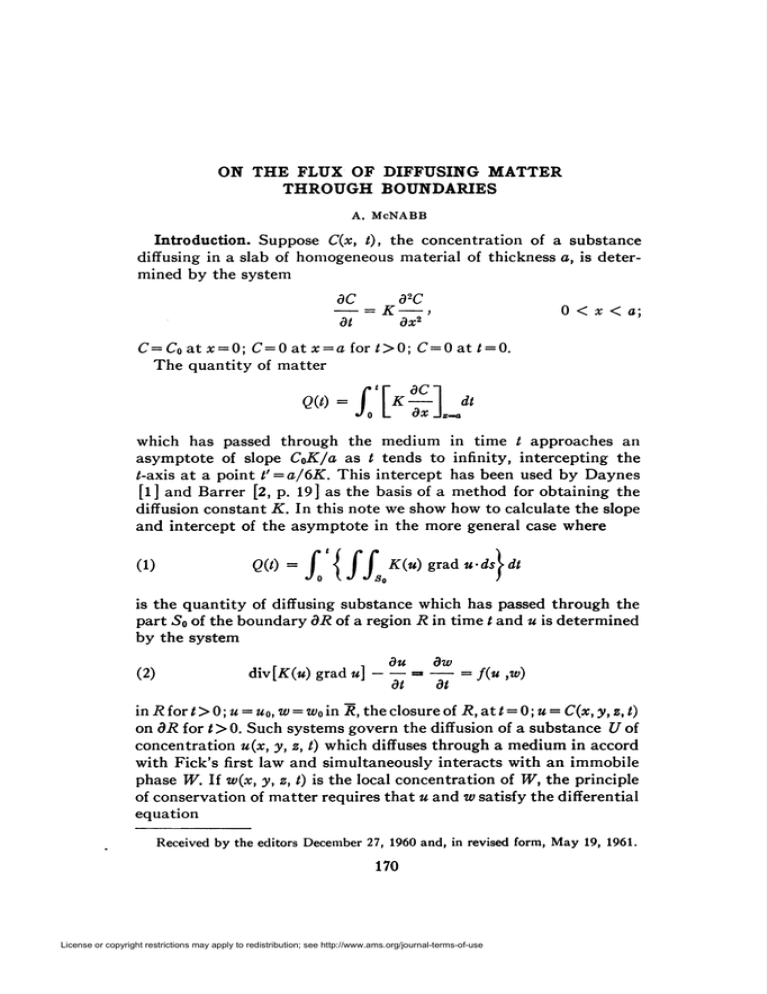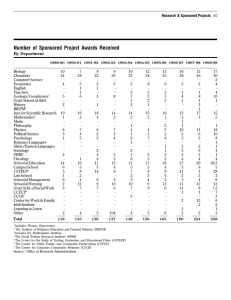(1) Qit) = f I f f Kiu) grad u
advertisement

ON THE FLUX OF DIFFUSING MATTER
THROUGH BOUNDARIES
A. McNABB
Introduction.
Suppose C(x, t), the concentration
of a substance
diffusing in a slab of homogeneous material of thickness a, is deter-
mined by the system
dC
-=
d2C
K-,
dt
C=C0atx
0 < x < a;
dx2
= 0; C=0 at x = a for ¿>0; C=0aU
The quantity
= 0.
of matter
Qit)=
\K—\
JJoo L
dt
dx Ax~a
_U
dx
which has passed through the medium in time t approaches an
asymptote
of slope CoK/a as t tends to infinity, intercepting
the
¿-axis at a point t'=a/6K.
This intercept has been used by Daynes
[l] and Barrer [2, p. 19] as the basis of a method for obtaining the
diffusion constant K. In this note we show how to calculate the slope
and intercept of the asymptote in the more general case where
(1)
Qit)= f I f f Kiu)gradu-ds\dt
is the quantity of diffusing substance which has passed through the
part So of the boundary 37? of a region 72 in time / and u is determined
by the system
r
(2)
n
div[7i:(w) grad«]-=
du
dw
dt
dt
/(« ,w)
inRíort>0;u
= u0lw = WoinR, the closure of 7?, at t = 0 ; u = C(x, y, z, t)
on dR for t>0. Such systems govern the diffusion of a substance i7of
concentration
w(x, y, z, t) which diffuses through a medium in accord
with Fick's first law and simultaneously
interacts with an immobile
phase W. If w(x, y, z, t) is the local concentration of IF, the principle
of conservation of matter requires that u and w satisfy the differential
equation
Received by the editors December 27, 1960 and, in revised form, May 19, 1961.
170
License or copyright restrictions may apply to redistribution; see http://www.ams.org/journal-terms-of-use
FLUX OF DIFFUSING MATTER THROUGH BOUNDARIES
du
dw
—-\-=
dt
dt
(3)
throughout
171
div[K(u) grad u]
the region 7? defined by the medium. The second equation
dw
(4)
—- = f(u, w)
at
describes the local law governing the rate of interchange
between the two phases U and W.
Calculation
of the asymptote.
Let D denote
of matter
the open region
{(x, y, z, t): (x, y, z)ER, t>0] and D its closure. Suppose u and w
are continuous in D, while in D, dw/dt is continuous, the second order
space derivatives and the ¿-derivative of u are also continuous and
these derivatives satisfy the pair of equations (3) and (4). The function K(u) is assumed to be positive and have a continuous derivative
for all admissible values of u. In addition, suppose ux, w„ are defined
and continuous in R with continuous derivatives satisfying the system
(5)
div [/£(««,) grad u«,] = 0 = /(«„, wx)
in 7?, while u and w and their derivatives approach the corresponding
values of ux, wx and their respective derivatives at each point of R.
The flux of U over a part S0 of the boundary 57? is
(6)
F(t) = - j J [K(u) grad«]-ds
J J So
and as t tends to infinity
this approaches
(7)
-
F(*)=
The amount
(8)
of phase
the constant
f ( [K(u„) grad ux]-ds.
J J s„
U which has passed through
Q(t)= f F(r)dT= F(tt)t" o
value
S0 in time t is
f [F(oo)- F(T)]dr.
J o
It will be shown that f¿[F(x>) —F(r)]dr
tends to a constant
A as ¿
tends to infinity.
Let us define <p(x, y, z, t) as fu[x;^)K(d)dd
fkp(x, y, z, r)dr in D, so that
License or copyright restrictions may apply to redistribution; see http://www.ams.org/journal-terms-of-use
and \y(x, y, z, t) as
172
A. McNABB
V2uV= —
[February
div{7f(«) grad u — i(»J
Jo
C ' Vdu dw "1
grad un}dr
= «o + wo — u(x, y, z, t) — wix, y, z, t)
in 7? for each value of t, while on the boundary
/* t
dR,
y» u{X,v,z,oo
K{e)dedr
(10)
-
Jo
Ju(l,y,i,r)
r
/•«(*.».«.«)
t
-|<
/•*
¿>M
K(B)d6 + I t7C(m)— dr.
L Ju(X,y.i,r)
Jo
J 0
dr
In the limit as / tends to infinity, yptends to a function
the system
\pK defined by
VVoo = «o + wo — m„ — w„ in 7?,
f* =
•7o
tTÍ(m) — dr on dP
dr
provided this last integral exists and is continuous
dR, and the boundary is sufficiently smooth.
Now
at each point of
f [F(cc)- F(T)]dr
Jo
= — I I -j
[K(ux) grad ux — K(u) grad u]dr> -ds
= — I I grad \¡/•ds
and as / tends to infinity, the right hand side approaches
- If s,,grad \pa-ds.
Summarizing
these results, we see that
Q(t)~F(«>)i - A
where
License or copyright restrictions may apply to redistribution; see http://www.ams.org/journal-terms-of-use
the value
1962]
FLUX OF DIFFUSING MATTER THROUGH BOUNDARIES
F(co)
= -
| |
173
[K(uM) grad ux]-ds
'So
and
^ = -JXgradtn-ds.
The function
mmis determined
by the system
div[K(«„) grad «„] = 0 = /(««,, w„) in 7?,
where on dR,
ii«, = lim u(x, y, z, t) = lim C(x, y, z, /),
while the function
ypKsatisfies
VVM = uo + wo — ux — wx in 7?,
and the boundary
conditions
*„ = I
K(6)d6dT= I t7¡T(m)
— dY
«'o
•7U(i,v,í.t)
«/o
¿V
onôT?.
In the case where So coincides with the whole surface 57?, an application of the divergence theorem shows that
-J7J>
as one would
expect
Uo + wx — wo]dV,
from the conservation
principle.
If ux = wx = 0,
i/'« is determined by the initial values of u and w and the boundary
values of u, so that the total quantity of diffusing matter which flows
over any part S0 of the boundary 37? is independent of the function
K(u). In particular, if a hollow cylinder is saturated under a boundary concentration
C0 and then removed from the saturating environment, the proportion of its contents which flow through the internal
cylindrical boundary is independent of K(u) and the function/(w,
w)
describing the interaction between the phases « and w.
As an example of this method, suppose
d r
du~\
dx L
dxj
— K(u) —
and u satisfies the boundary
du
= —,
conditions
dl
0<x<a,
u = 0 at f = 0 on (0, a), while
License or copyright restrictions may apply to redistribution; see http://www.ams.org/journal-terms-of-use
174
A. McNABB
u=Co at x = a and u = 0 at x = 0 for all i>0. The time integral
the flux through unit area of the face at x = 0 is asymptotic
of
to
F(<x>)t—A. Since
d r
dua~\
-dx\_Uw-
dxj
=o,
we see that
I
K(0)dO= —x where b = j
Jo
a
Jo
K(6)dO,
and hence
P(oe) =
r
toxl
*(«.) —
L
b
-—-I
ox Jo
Cc" K(6)
— <**•
a
^o
ß
Again,
—— = - M«, m (0, a),
dx2
while ^00= 0 at x = 0 and x = a and therefore
J.i
x /.o
(x — z)uK(z)dz + — I (a — z)um(z)dz,
o
a J o
^ =
-
L dx Jo
a
= — I
rc"V
a Jo
(a — 2)mw(2)íÍ3 = — I
2a Jo
/ Pu"
/
C0"
(a — 2)2dMw
\T
-if. L1
-CX""/J. ««*)]*Evidently C0a/2 > .4 > 0.
Let us finally note that the method depends on the fact that u
satisfies a conservation
law of the form \/2<p= dq/dt where <p is a
known function of u, while q is given initially and at <= » and m has
known values on dR.
References
1. H. Daynes, Process of diffusion through a rubber membrane, Proc. Roy. Soc.
97A (1920), 286.
2. R. M. Barrer, Diffusion in and through solids, Chapter
1, Cambridge
Univ.
Press, New York, 1941.
Applied Mathematics Laboratory,
Department
trial Research, Wellington,
New Zealand
of Scientific
License or copyright restrictions may apply to redistribution; see http://www.ams.org/journal-terms-of-use
and Indus-



